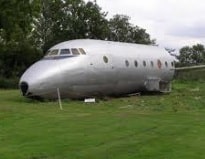 The French word fuselage came into our language as fuselage . This is what the body of an aircraft is called: that is, the structure in which people travel and goods are transported.
The French word fuselage came into our language as fuselage . This is what the body of an aircraft is called: that is, the structure in which people travel and goods are transported.
The fusiform (spindle-shaped) fuselage allows the plane to be aerodynamic and, therefore, move more easily through the air. The design of the fuselage also allows this sector to serve as support for the other components of the vehicle, such as the wings, landing gear, etc.
Passengers , crew and cargo of an aircraft travel in the fuselage. Therefore, the passenger cabin, the cockpit, all the equipment and systems necessary to control the airplane and the cargo hold are in the fuselage. The shape and size of the fuselage, however, varies according to the characteristics and use of the aircraft.
The design and manufacturing of the fuselage includes multiple safety measures. For example, the fuselage must have different exits to facilitate the evacuation of the plane in cases of emergency. It must also allow the supply of the vehicle and its inspection.
A wide-body aircraft is known as one that has two passenger aisles, which is why it is also called double-aisle . It is an airliner, meaning it must be operated by an airline and is used for commercial flights hired by private individuals. Among its basic features is a space for customers ' luggage.
In the case of the twin-aisle aircraft, the diameter of its fuselage has an average of 5.5 meters. In the passenger cabin of most airplanes of this type intended for economy class, the rows of seats have a minimum of seven and a maximum of ten seats, giving the ship a maximum capacity of between two hundred and six hundred passengers. The largest in the world is over 6 meters wide and has rows of up to eleven seats.
 It is worth mentioning that on a wide-body aircraft it is also possible to transport goods and other commercial goods, instead of passengers. In its counterpart, the narrow fuselage, the diameter does not exceed 4 meters and there is a single aisle with rows of six seats or less. Precisely, the double aisle ones emerged with the objective of combining efficiency and passenger comfort.
It is worth mentioning that on a wide-body aircraft it is also possible to transport goods and other commercial goods, instead of passengers. In its counterpart, the narrow fuselage, the diameter does not exceed 4 meters and there is a single aisle with rows of six seats or less. Precisely, the double aisle ones emerged with the objective of combining efficiency and passenger comfort.
Since the birth of wide-body aircraft, airlines have looked for a way to increase their income on each commercial flight, and to do so they went against the philosophy of these aircraft, reducing the extra space that characterized them, to accommodate more people per trip. In fact, both the size and distribution of the seats and fuselage aisles can vary significantly between one model and another, since they depend on the internal decisions of each company .
These differences can be easily seen when comparing wide-body airplanes designed for short flights with the others: in the former, the seating density is much higher than in those for long flights, since passengers must spend less time on the plane. .
It should be noted that, when a plane stops flying or is dismantled, the fuselage can be used in various ways. There are cases of people who have built their home in a fuselage. In Costa Rica , on the other hand, there is a pub , bar and restaurant that operates inside a fuselage, where a suite was also set up.
